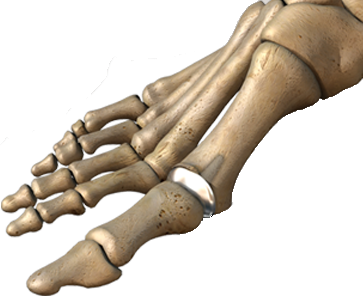The 26 Review
- What is Big Toe Joint Replacement A surgical procedure replacing the big toe joint with an artificial joint made of metal or plastic
- How Damaged cartilage and bone is removed and replaced with an artificial joint
- Why To decrease pain and improve function of the big toe joint
- Recommended for Patients experiencing persistent pain, swelling, stiffness, and prominent bone in the big toe joint
- Length of Treatment Surgery lasts roughly 1 hour, depending on the severity of the damaged big toe joint
- Downtime 4 weeks of decreased activities

Let’s take a closer look…
Big toe joints can cause patients of any age pain, swelling, and/or bruising. Common pre-existing conditions or injuries to the big toe joint can typically be treated with OTC medications. However, when conservative treatments do not resolve big toe joint stiffness or pain, consulting a podiatrist is highly recommended. A number of conditions can make patients candidates for big toe joint replacement. These pre-existing ailments include, arthritis, prior history of trauma to the big toe, untreated bunions, pre-existing hallux limitus, and other congenital foot conditions. One of the most common big toe joint conditions is hallux limitus, which is a loss of motion in the big toe. In conjunction with hallux limitus, hallux rigidus is a condition where the big toe joint stiffens as cartilage is damaged or lost. Overtime, both of these conditions can lead to arthritis and damage the big toe joint further. If you are experiencing pain or limited mobility in the big toe, consider contacting a podiatrist to determine if big toe joint replacement surgery is right for you.
Procedure Details: Pre, During & Post Surgery Expectations
Prior to surgery being able to take place, all patients should consult their podiatrist with any questions and concerns, as well as inform their podiatrist of pre-existing ailments. When consulting with a podiatrist, physical exams will take place. X-rays will most likely be required during a consultation to determine the severity of the damage done to the big toe joint. A patient may be informed to decrease activity levels prior to surgery to ensure further damage to the joint is not made.
During the surgery, patients will be placed under twilight anesthesia to ensure no pain or discomfort is felt. The surgeon will first create an incision on the top of the big toe. Once inside, a surgeon may need to remove any damaged cartilage portions surrounding the big toe joint. At this time, if a patient has any bone spurs (lumps) they will be shaved smooth as well. After, the bone surfaces will be prepared for the artificial joint to be attached. The doctor will use a prosthetic made of metal or plastic to replace part or the entirety of the big toe joint. The choice of prosthetic and extent of the surgery will vary depending on each patient’s situation. When the bone surfaces are prepared, the surgeon will attach the chosen prosthetic and then close the wound with stitches or staples.
Big toe joint replacement surgery is an outpatient surgery, meaning that patients may return home the same day of their surgery. It is highly recommended that patients plan to have someone drive them home after the surgery. After the wound has been closed with stitches or staples, the foot will be covered in dressings. Most patients will be required to wear a boot for up to 2-4 weeks. Podiatrists may also give recovering patients a special shoe that makes it easier to avoid putting full weight on the new toe joint. Setting up appointments with a physical therapist after the surgery is optional during the healing process. OTC pain medications can be taken after the surgery to decrease any pain or inflammation. Most patients are able to return to physical activities after 6 weeks of recovery. Swelling can potentially last for months following the procedure.
Benefits and Risk Factors
Like most surgeries, big toe joint replacement surgery has its benefits and risk factors. Patients who chose to receive this surgery experience a significant amount of pain relief within hours of completion. After 3-4 days of rest and elevation, patients are able to walk normally with the aid of a boot. In company with the previous statements, the prosthetics used these days in most cases are seen to hold up longer than our own bones. With every surgery there comes the potential risk for problems. Luckily, most of the potential issues that could arise are preventable and fixable. Some risks associated with anesthesia include infection, damage to nerves and blood vessels, and bleeding or blood clots. Specific complications for joint replacement include the failure of the implant to take. This can be associated with the death of the bone due to the interruption of blood supply and much more. Joint replacement failure can make subsequent fusion or additional joint replacement difficult. Although joint replacement risks are rare, if they do occur a podiatrist is more than capable of fixing the issue. Speaking with a podiatrist prior to a surgery is always recommended to ensure all questions and concerns can be answered.